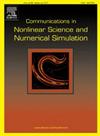配备摩擦调谐质量阻尼器的被动/主动基础隔震建筑的最优非线性分数阶控制器
IF 3.4
2区 数学
Q1 MATHEMATICS, APPLIED
Communications in Nonlinear Science and Numerical Simulation
Pub Date : 2024-10-22
DOI:10.1016/j.cnsns.2024.108405
引用次数: 0
摘要
本文介绍了一种最优非线性分数阶控制器(ONFOC),旨在降低装有基底隔震(BI)系统和摩擦调谐质量阻尼器(FTMD)的高层建筑的地震响应。采用多目标量子启发海鸥优化算法(MOQSOA)分别优化了 BI 和 FTMD 系统及其组合(BI-FTMD 和主动 BI-FTMD 或 ABI-FTMD)的参数。评估了 BI、FTMD、BI-FTMD 和 ABI-FTMD 系统在一栋 15 层建筑中的抗震性能,该建筑分别遭受了两次远场地震(洛马普列塔地震和兰德斯地震)和两次近场地震(塔巴斯地震和北岭地震)。结果表明,采用 BI、FTMD、BI-FTMD 和 ABI-FTMD 系统的结构在减少设计地震(洛马普列塔地震和塔巴斯地震)期间的结构响应方面优于未受控制的结构。然而,在验证地震(兰德斯地震和北岭地震)中,使用 FTMD 系统的建筑物在近场北岭地震中的峰值加速度比未受控制结构的峰值加速度更差。为解决这一问题,我们提出了将主动 BI 系统和 FTMD 系统相结合的方案。时间历程分析结果表明,与未受控结构相比,装有主动式 BI 系统和 FTMD 系统的建筑物的峰值位移、峰值加速度和峰值层间漂移分别减少了约 60%、64% 和 78%。本文章由计算机程序翻译,如有差异,请以英文原文为准。
An optimal nonlinear fractional order controller for passive/active base isolation building equipped with friction-tuned mass dampers
This paper presents an optimal nonlinear fractional-order controller (ONFOC) designed to reduce the seismic responses of tall buildings equipped with a base-isolation (BI) system and friction-tuned mass dampers (FTMDs). The parameters for the BI and FTMD systems, as well as their combinations (BI-FTMD and active BI-FTMD or ABI-FTMD), were optimized separately using a multi-objective quantum-inspired seagull optimization algorithm (MOQSOA). The seismic performances of the BI, FTMD, BI-FTMD, and ABI-FTMD systems for a 15-storey building subjected to two far-field (Loma Prieta and Landers) and two near-fields (Tabas and Northridge) earthquakes were evaluated. The results indicated that structures with BI, FTMD, BI-FTMD, and ABI-FTMD systems outperformed the uncontrolled structure in reducing structural responses during the design earthquakes (Loma Prieta and Tabas). However, under validation earthquakes (Landers and Northridge), the peak acceleration of the building with the FTMD system was worse than that of the uncontrolled structure during the near-field Northridge earthquake. To address this issue, we proposed a combination of the active BI system and the FTMD system. Time history analysis results demonstrated that for the building equipped with the ABI-FTMD system, the peak displacement, peak acceleration, and peak inter-storey drift were reduced by approximately 60%, 64%, and 78%, respectively, as compared to the uncontrolled structure.
求助全文
通过发布文献求助,成功后即可免费获取论文全文。
去求助
来源期刊

Communications in Nonlinear Science and Numerical Simulation
MATHEMATICS, APPLIED-MATHEMATICS, INTERDISCIPLINARY APPLICATIONS
CiteScore
6.80
自引率
7.70%
发文量
378
审稿时长
78 days
期刊介绍:
The journal publishes original research findings on experimental observation, mathematical modeling, theoretical analysis and numerical simulation, for more accurate description, better prediction or novel application, of nonlinear phenomena in science and engineering. It offers a venue for researchers to make rapid exchange of ideas and techniques in nonlinear science and complexity.
The submission of manuscripts with cross-disciplinary approaches in nonlinear science and complexity is particularly encouraged.
Topics of interest:
Nonlinear differential or delay equations, Lie group analysis and asymptotic methods, Discontinuous systems, Fractals, Fractional calculus and dynamics, Nonlinear effects in quantum mechanics, Nonlinear stochastic processes, Experimental nonlinear science, Time-series and signal analysis, Computational methods and simulations in nonlinear science and engineering, Control of dynamical systems, Synchronization, Lyapunov analysis, High-dimensional chaos and turbulence, Chaos in Hamiltonian systems, Integrable systems and solitons, Collective behavior in many-body systems, Biological physics and networks, Nonlinear mechanical systems, Complex systems and complexity.
No length limitation for contributions is set, but only concisely written manuscripts are published. Brief papers are published on the basis of Rapid Communications. Discussions of previously published papers are welcome.
 求助内容:
求助内容: 应助结果提醒方式:
应助结果提醒方式:


